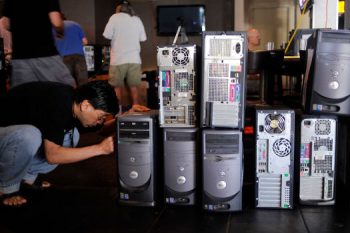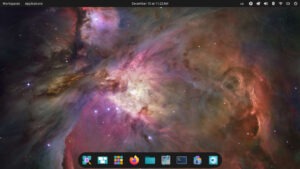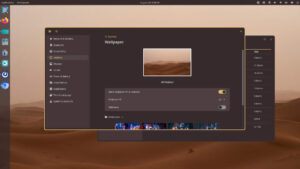A talk with Randy Noseworthy, the man behind the Linux respins on the old computers that Reglue makes new again.
The Heart of Linux
It started back in 2009, the first year of Lynn Bender’s fantastic brainstorm “Linux Against Poverty.” Lynn’s idea and subsequent involvement with our organization, then named The HeliOS Project, would infuse our effort with an energy and inventory we still rely on today.
 Bender contacted me early in 2009 and proposed we organize an event to bring the greater Austin community, the Austin Tech community and HeliOS under one roof. We would ask people to bring unused or broken computers to our event. Through Lynn’s network connections, a 6th Street bar owner gave up his bar for an entire Saturday. That, in turn, allowed over 50 Austin geeks to converge on 6th Street to set up stations and transform the broken computers coming in the front door into fully-functioning computers going out the back door and into our waiting truck.
Bender contacted me early in 2009 and proposed we organize an event to bring the greater Austin community, the Austin Tech community and HeliOS under one roof. We would ask people to bring unused or broken computers to our event. Through Lynn’s network connections, a 6th Street bar owner gave up his bar for an entire Saturday. That, in turn, allowed over 50 Austin geeks to converge on 6th Street to set up stations and transform the broken computers coming in the front door into fully-functioning computers going out the back door and into our waiting truck.
It was during the 2009 event that Andy Krell, the now sitting president of Reglue, suggested we respin a Linux distro to include the educational applications we usually install later. He noted that adding the required software to the operating system at a later date was wasted time. That made sense from a time management point of view, and it insured that anyone from Reglue revisiting the computer had a leg up on what was already on it.
In those early days we meandered from Knoppix to Mandrake, and ultimately found that MEPIS proved to be the most stable. The system installed without drama and the user forums were kid-friendly. The fact that Warren Woodford was often found active in the forums was a bonus.
However, MEPIS began to fade. Eventually Woodford announced he would no longer develop the distro. Between not being able to pay the bills and a nasty kerfuffle with those who enforce the GPL, MEPIS sank into history. Fortunately, I had already been playing with Ubuntu. When I discovered the distro-creating tool UCK, we had our first custom distro.
Over time, however, there were periods when UCK would suffer some major stability problems and it became a concern that it would not be of use to us, which turned out to be only too true. Since Reglue counted heavily on the right software being on the right computers, we began looking for alternatives. With more of my time being taken by cancer treatments and the subsequent recovery time from cancer treatments, our software was becoming dated.
That’s when I began to talk with Randy Noseworthy, an Ohio guy making his living in and around tech. Being a Linux guy as well, it was only a matter of time until we ran into each other on Google Plus, and we were able to meet when I was invited to keynote at Ohio LinuxFest in 2014.
Randy had already done considerable work for Reglue by that time, creating for us custom Linux systems. While most of our computers leave the shop with the same specs, there are times when we will put out specialized machines or machines that will only be used for extremely light tasks. For those computers, the full-on custom distro would overwhelm the smaller two gig machines we provide. It was Randy Noseworthy who put together the multiple distros we would need throughout the year.
At this point we have two distros we install on Reglue computers. Our go-to install which is the LTS Linux Mint Cinnamon 14.04, or “CinnaMint,” and the other is a Ubuntu respin of the Mate desktop. Surprisingly, Mate seems to compete strongly with the known “lite” desktop environments such as LXDE and Xfce. Noseworthy has used a number of tools in creating these distros for us, thus one would assume him to be of the Linux elite. As he states, however, nothing could be further from the truth.
“Well, I always feel like a bit of a ‘Linux fraud,’ as I don’t work on Linux as a professional, like Rikki Endsley or Popey [Alan Pope, community manager at Canonical]. It took years for me to feel like I was a real PC tech vs being a fraud, mainly due to the fact that I had some offbeat idea that I’m supposed to know 100 percent of everything. That’s impossible. But I guess as a PC repair/deskside tech/system administrator (the name changes depending on who you’re working for), I hit some tipping point somewhere along the way and felt like I was justified to hold that kind of title.
“Silly, eh? Maybe I’m just not good at tooting my horn. I’m a good smart ass, due to the practice I’ve had, but not so good at horn tootin’. I guess you could say that I’m not soaking enough in Linux/FOSS all day everyday, but rather I’m a happy layman that enjoys learning new things.”
So in your work and experimentation, which tools work for this job and which do not?
“SquashFS so far has proven the basic and best all around tool to use. I started off doing this for you a few years ago using MintConstructor, as you know, but that went kaput. I was already familiar with MintConstructor. I had successfully used it to remove packages to make a CD sized image for a PC that didn’t want to boot off a USB drive.
“I’ve also used UCK for the Ubuntu respins for you, and that seems to work fairly well too. Martin Wimpress suggested Pinguy Rebuilder, and that worked okay for the latest Ubuntu MATE respin, but it pulls in to much of the current system by default. It’s different, but like any of the tools, there is a pro and con to each one. We tried using Systemback for an ISO for you, but from what I recall that had sucked in WAY to much info from the current user versus something from the base ISO just adding the packages and other stuff you wanted. It seemed like a good tool for what it was intended for, though.
“The last respin that I made for you, with Pinguy Builder, seems to be working okay. Right? But I think that the next one — Mint 18, since it’s out — I’ll just go back to using the standard script that I’ve used using SquashFS. I’ve just been waiting for their release of it, and a weekend where I can dedicate some time to get it done.”
So if you could isolate or name one PITA thing about making these respins, what would that be?
“One of the fun challenges is trying to figure out where the default background is, and replacing it. It seems that there’s always some slight variation as to how or where it’s kept. Could just be me, but there doesn’t seem to be a default way of doing it for every desktop environment and distro.
“With the respins, I’m at a point where it’s a bit of fun, and sometimes very little challenge, so that’s good. I hate when there’s a problem that you stumble upon and can’t figure out the answer.”
I think the most important thing that can be taken away from this relationship between Randy Noseworthy and Reglue is this: It doesn’t matter what your “credentials” are. Most times, it’s not even relevant what your post secondary education is…or what some framed parchment hanging on your wall may decree. What it comes down to is the spirit of open source…sharing and learning, passing it along and becoming part of a greater thing aside from yourself. That’s what Noseworthy has done, and in the spirit of all things open source, I’ll buy him a glass of tea at the next Ohio LinuxFest we attend.
Ken Starks is the founder of the Helios Project and Reglue, which for 20 years provided refurbished older computers running Linux to disadvantaged school kids, as well as providing digital help for senior citizens, in the Austin, Texas area. He was a columnist for FOSS Force from 2013-2016, and remains part of our family. Follow him on Twitter: @Reglue









Just for comparison I’ll mention Fedora. Fedora ships the kickstart files they use to build each desktop spin in every release (spin-kickstarts and fedora-kickstarts) and tools for building install-only (which I haven’t used) and live installable media (lorax and livecd-tools). They also include an easy way to remove the Fedora branding (generic-logos and generic-release). With all of those pieces it is easy enough to refresh their existing spins or make modifications to build your own custom spin or remix. Pretty much the same tools work for RHEL and clones.
Have you folks encountered LXLE? It’s a special version of Lubuntu, the lightest-weight of the official Ubuntu remixes, optimised for older hardware.
http://www.lxle.net/
Cinnamon is a lot less than ideal, because it uses a desktop compositor. This requires hardware OpenGL. If the graphics driver doesn’t do this, it emulates it using a thing called “LLVMpipe”. This process is slow & uses a lot of CPU bandwidth. This is true of all desktops based on GNOME 3 — including Unity, Elementary OS, RHEL/CentOS “Gnome Classic”, SolusOS’s Consort, and more. All are based on Gtk 3.
In KDE, it is possible to disable the compositor, but it’s still very heavyweight.
The mainstream desktops that do not need compositing at all are, in order of size (memory footprint), from largest to smallest:
* Maté
* Xfce
* LXDE
All are based on Gtk 2, which has now been replaced with Gtk 3.
Of these, LXDE is the lightest, but it is currently undergoing a merger with the Razor-Qt desktop to become LXQt. This may be larger & slower when finished — it’s too soon to tell.
However, of the 3, this means it has a brighter-looking future because it will be based on a current toolkit. Neither Maté nor Xfce have announced firm migration paths to Gtk 3 yet.
The legacy of Mepis is still alive.
Warren is not involved, but the original community is largely still functioning.
http://forum.mepiscommunity.org
The latest is MX-15. A polishing of debian stable (like Mepis was) with xfce DE.
And the lighter Anti-X for older systems has lighter DEs.
The community is still great and helpful, and MX-15 has some great tools still hearkening back to the Warren days. MX-15 is rock solid with many updated programs in the repos.
@Liam Proven
You’re right that it’s better to have a choice about whether compositing is turned on because of hardware limitations. However, in my experience almost all desktops run better on the lion’s share of hardware dating back up to ten years or more with hardware compositing of some sort running.
I could check when I’m home, but I seem to remember that I’m running a compositor on the 2003 IBM Thinkpad that someone gave me with a Pentium 4 and a buggy Intel video chipset because it runs better that way (Salix OS Fluxbox edition and Compton for compositing). I run a compositor on old Asus Eee model netbooks with Celeron processors and Intel i915 video because they run better with hardware accelerated compositing enabled.
I suspect that why Cinnamon is not a problem for Reglue is because all of the hardware they put it on is perfectly capable of running hardware accelerated compositing using OpenGL. If it’s not, they switch to Ubuntu Mate or simply don’t deploy the hardware.
LXLE is a nice distribution, and very pretty. I know that Ken is at least somewhat familiar with it because of past articles. However, some of the extra repositories they pull in make updating a bit flaky and requiring more hand-holding than I would prefer to put on a kid’s machine (I have deployed a machine for a group of kids with LXLE before and advised them how to deal with it, but it’s not something I’m likely to do again). Regular Lubuntu may not be as pretty, but updating it is very straightforward, and you can always add the applications and wallpapers you want.
Another thing about LXLE is that they recently switched from defaulting to a standard LXDE type desktop with some added programs (which is similar to older Windows desktops in structure) to defaulting to LXDE modified to act like Gnome 2, which I personally don’t like as well.
@Liam Proven and @ CFWhitman
Thanks, Liam, for the explanation. I one was testing a distribution and after testing KDE, Xfce, LXDE and Mate, I would give a try to Cinnamon on an old PC and was overwhelmed at how bad it ran. After seeing those DEs work rather well (for the computer had enough RAM), it was rather unexpected to see a newer (and thus supposedly better) DE perform slowly. I mean molasses-like slowly.
Looking for the LLVMpipe thing (if I understood it correctly), it is used for just-in-time compiling — the kind of thing you really don’t want to have on dated hardware. Perhaps things have improved in the last two years, but let’s say Cinnamon (and Gnome 3) are like the last options I’ll try, that is after no other desktop worked.
Alas, I have a couple of older PCs — which nonetheless work rather well for a variety of tasks.
For classification purposes, I divided tasks as:
1- Simple games: text- or DOS-based ones (e.g. XGalaga, Chromium BSU, SuperTux), turn-based (like Solitaire) and even educational programs like gCompris.
2- Low AV: audio playing and low resolution (640×480) video — surprisingly useful for Youtube.
3 – Dedicated: proxy, firewall, fileserver, simple webserver etc.
4 – Work: Libreoffice, ImageMagick, GIMP, Firefox (no adblocking but without flash) and
5- Hi-video: playing 720p, faster games (e.g. first person shooters) and the like.
(actually, I have another category: “cloud”)
I also reasoned about — after the kernel, Xorg and a main application (e.g. Libreoffice, Firefox etc.) are loaded — what is the effect of some DEs, as measured by unused percentage of memory (wrt to e.g. total memory. I could then stablish a minimum amount of desired free memory (say, 60%) and see what DEs I could use on a given hardware.
This must be still revised for errors, but an initial conclusions are:
a) many PCs which are dismissed because they can’t play Flash or a “favorite movie streaming service” are still quite good for various types of serious work;
b) if you have one PC, just like having one car, it must be good for everything (just like a commuting car must also serve for 5-people traveling with lots of luggage); a second PC (or car) might be a lot less powerful with regard to video (for instance), or just be good for video playing even if it has just 1 GB RAM;
c) finally, Windows people throw away 2 GB RAM notebooks… which may be excellent for Linux — and cheap!
d) some distributions really want to be ahead of Windows — including with regard to system requirements 🙁 …it’s important to avoid them…
For me, reusing PCs is very exciting considering some distributions really are beautiful and make an old horse look anew.
Besides the economic and ecological aspects, that may make a deep difference in the life outcome of some intelligent but poorer fellows.